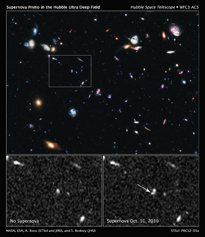January 17, 2012
Hubble detects one of the most distant supernovae yet observed

These three images taken by NASA’s Hubble Space Telescope reveal the emergence of an exploding star, called a supernova. Nicknamed SN Primo, the exploding star belongs to a special class called Type Ia supernovae, which are distance markers used for studying dark energy and the expansion rate of the universe. The top image shows part of the Hubble Ultra Deep Field, the region where astronomers were looking for a supernova blast; the box shows where the supernova is later seen. The bottom left image is a close-up of the field without the supernova. A new bright object, identified as the supernova, appears in the image at bottom right. Photo: NASA, ESA, A. Riess and S. Rodney
A team of Johns Hopkins astrophysicists using NASA’s Hubble Space Telescope has detected a distant Type Ia supernova, the farthest stellar explosion that can be used to measure the expansion rate of the universe. The supernova is the remnant of a star that exploded 9 billion years ago. The sighting is the first finding of an ambitious survey that will help astronomers place better constraints on the nature of “dark energy,” a mysterious repulsive force that is causing the universe to fly apart ever faster.
The object, nicknamed SN Primo, belongs to a special class called Type Ia supernovae, which are bright beacons used as distance markers for studying the expansion rate of the universe. Type Ia supernovae most likely arise when white dwarf stars, the burned-out cores of normal stars, siphon too much material from their companion stars and explode.
The study has been accepted for publication in The Astrophysical Journal, and the results were presented Jan. 11 at the American Astronomical Society meeting in Austin, Texas, by first author Steven Rodney, a postdoctoral researcher in the Henry A. Rowland Department of Physics and Astronomy at The Johns Hopkins University. Teaming with Rodney was lead investigator Adam Riess, a professor of physics and astronomy at Johns Hopkins and a 2011 winner of the Nobel Prize in physics for his discovery of dark energy.
According to Rodney, SN Primo is the farthest Type Ia supernova whose distance has been confirmed through spectroscopic observations. A spectrum splits the light from a supernova into its constituent colors. By analyzing those colors, astronomers can confirm its distance by measuring how much the supernova’s light has been stretched, or red-shifted, into near-infrared wavelengths due to the expansion of the universe.
The supernova was discovered as part of a three-year Hubble program to survey faraway Type Ia supernovae, enabling searches for this special class of stellar explosion at greater distances than previously possible. The remote supernovae will help astronomers determine whether the exploding stars remain dependable distance markers across vast distances of space in an epoch when the cosmos was only one-third its current age of 13.7 billion years.
Called the CANDELS+CLASH Supernova Project, the census uses the sharpness and versatility of Hubble’s Wide Field Camera 3 to look in regions targeted by two large Hubble programs: Cosmic Assembly Near-infrared Deep Extragalactic Legacy Survey (CANDELS) and the Cluster Lensing and Supernova Survey with Hubble (CLASH).
“In our search for supernovae, we had gone as far as we could go in optical light,” Riess said. “But it’s only the beginning of what we can do in infrared light. This discovery demonstrates that we can use the Wide Field Camera 3 to search for supernovae in the distant universe.”
The supernova team’s search technique involved taking multiple near-infrared images over several months, looking for a supernova’s faint glow. Once the team spotted SN Primo in October 2010, the scientists used the camera’s spectrometer to verify its distance and to decode its light, finding the unique signature of a Type Ia supernova. The team then re-imaged SN Primo periodically for eight months, measuring the slow dimming of its light.
By taking the census, the astronomers hope to determine the frequency of Type Ia supernovae during the early universe and glean insights into the mechanisms that detonated them.
“If we look into the early universe and measure a drop in the number of supernovae, then it could be that it takes a long time to make a Type Ia supernova,” Rodney said. “Like corn kernels in a pan waiting for the oil to heat up, the stars haven’t had enough time at that epoch to evolve to the point of explosion. However, if supernovae form very quickly, like microwave popcorn, then they will be immediately visible, and we’ll find many of them, even when the universe was very young. But each supernova is unique. It’s possible that there are multiple ways to make a supernova.”
If astronomers discover that Type Ia supernovae begin to depart from how they expect them to look, they might be able to gauge those changes and make the measurements of dark energy more precise. When Riess and two other astronomers discovered dark energy 13 years ago—the finding for which they shared the Nobel Prize in physics in 2011—they used Type 1a supernovae to plot the expansion rate of the universe.
The Hubble Space Telescope is a project of international cooperation between NASA and the European Space Agency. NASA’s Goddard Space Flight Center manages the telescope. The Space Telescope Science Institute conducts Hubble science operations. STScI is operated for NASA by the Association of Universities for Research in Astronomy.
For images and more information about the study, visit website

